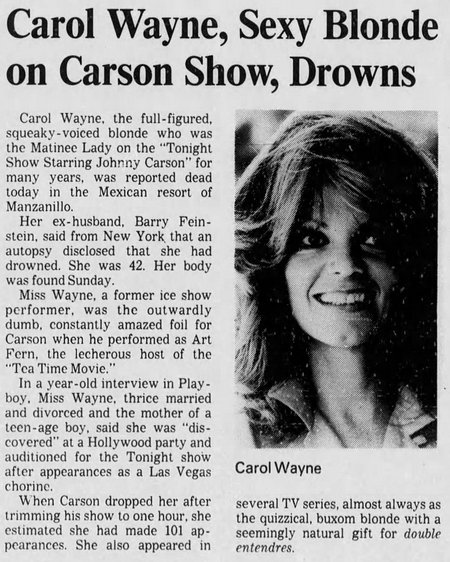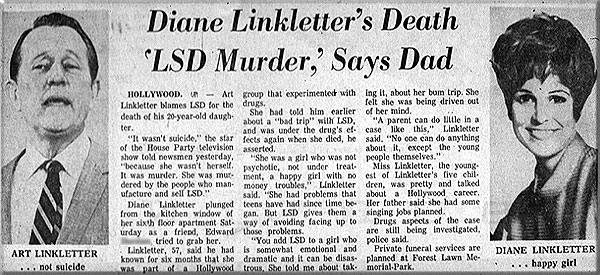
Emergency vehicles screeched up to the Shoreham Towers. Diane Linkletter was on the sidewalk, bleeding profusely from her head. She was still alive. A near neighbor, Jimmy George, witnessed Diane’s fall. He ran outside to see if he could render aid. She looked up at him but could not speak. Jimmy didn’t know what to do. Even if he had been a trained paramedic he could not have altered the outcome.
Diane was placed in an ambulance and rushed to the University of Southern California Medical Center. She was dead on arrival. The pretty girl with the bright smile, and future to match, was two weeks away from her 21st birthday.

Everyone wanted to know what had happened to Diane. Sheriff’s investigators began to piece together her last several hours to see if her death was a suicide, an accident, or a homicide.
The last person to see Diane was Edward Durston. Durston said he saw Diane on the day before her death. He said she was depressed and he was concerned about her. Following her date with Robert, she stopped in at Durston’s apartment. It was 3 a.m. She asked him to come by her place because she was going to bake cookies.
Durston told investigators that Diane had dropped acid that night. He said they talked for hours and she told him she was depressed. She went into her bedroom and telephoned her brother and, according to Durston, Diane seemed calmer.
Her calm demeanor is what fooled him, he said. He thought everything was fine until she walked into the kitchen, climbed onto the drainboard and into the window. Durston said he was frantic. He tried, but failed, to grab Diane’s belt. He said she went out the window and there was nothing he could do to stop her.
Durston’s account of events changed several times. He changing story made investigators suspicious, so they dug into his background. What they found gave them cause for concern.
The Tate/LaBianca murders were fresh in everyone’s mind and Durston was an early suspect in the slayings. Detectives asked Durston if he was willing to take a polygraph regarding the circumstances of Diane’s death and he agreed. The results were never made public.

Sharon Tate and Roman Polanski
At the same time Durston was grilled by Sheriff’s investigators, Diane’s father addressed reporters.
As you would expect, Art was devastated by Diane’s death. He told reporters he knew what killed her – LSD. It wasn’t until after the autopsy revealed that Diane had no drugs in her system that Art offered a revised version. He said that Diane experienced an acid flashback and that is what propelled her out of her kitchen window.

Building on a tale of dubious origin, the media added a few flourishes and the next thing anyone knew Diane Linkletter had gone out the window of her apartment, high on LSD, because she thought she could fly.
The story degenerated into a false, but often repeated, narrative of Diane’s life. According to various sources Diane was into heroin at 13 and her drug use continued at a mad and dangerous pace until her death. None of it was true. Did Diane experiment with drugs? If she did, it wasn’t a big part of her life.
Sheriff’s homicide detective, Norm Hamilton, interviewed Diane’s ex-husband Grant Conroy. Theirs was a whirlwind marriage and it seemed doubtful Grant could offer any substantive information, but he had to be asked.
Grant said Diane used LSD and speed while they were married. How he knew intimate details of her life is a mystery—Diane never lived with Grant. During their brief marriage she lived at home with her parents.
Detectives turned again to Durston. He was the last person with Diane. Could he have pushed her? They never found any evidence to suggest foul play. However, Durston was present at another mysterious death in 1985.
Actress Carol Wayne appeared regularly on TV shows during the 1960s and into the 1970s. Her biggest role was in sketches on the Johnny Carson Show. She always played a ditzy blonde. When Carson asked the network to reduce his show from 90 to 60s minutes, Carol’s role was over.
https://youtu.be/pVy-pPWDK6c?t=103
She began to abuse alcohol and cocaine and it is rumored that she became an escort for wealthy men. In January 1985 she accompanied Durston to a resort in Mexico. The couple reportedly had a disagreement and Carol went for a walk on the beach to cool off. When she didn’t return for their flight back to Los Angeles, Durston left without her. He left her bags at the airport with a note that she would come and pick them up. She never arrived.
 Carol’s fully clothed body was found floating in four feet of water off the beach near the hotel where she and Durston stayed. There were no signs of foul play. People who knew Carol found it strange that she drowned. She was terrified of water.
Carol’s fully clothed body was found floating in four feet of water off the beach near the hotel where she and Durston stayed. There were no signs of foul play. People who knew Carol found it strange that she drowned. She was terrified of water.
It is ironic that the person most responsible for trashing Diane’s reputation was her father. With no verifiable evidence that Diane abused drugs, Art embarked on a nationwide anti-drug campaign using Diane as a tragic example of how drugs can kill.

Why was Art so keen to tarnish Diane’s reputation by alleging she was a drug user? The simplest explanation is that Art was in denial about Diane’s death and experiencing the pain and guilt that can come with surviving a loved one’s suicide. It isn’t unusual for the survivors to cast around for a scapegoat . Art chose drugs.
NOTE: If you or a loved one is contemplating suicide, please reach out for help.
National Suicide Prevention Lifeline
Call 1-800-273-8255 Available 24 hours everyday
